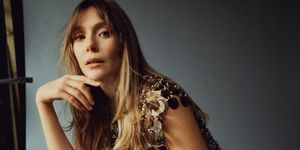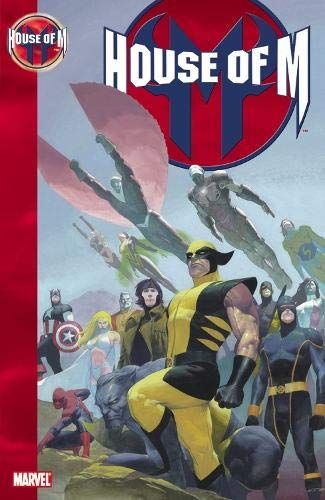By the end of 2020, the Marvel Cinematic Universe had started to feel a bit…stale. Part of what makes the superhero genre so universally captivating is its capacity to go where
other mediums can't. But by the end of Avengers: Endgame, the MCU was closing the door on a chapter that, no matter how wildly successful, had followed a series of predictable patterns. While that doesn't make watching Tony Stark save the world any less satisfying, it does make it less nerdy. And no matter how mainstream superheroes get, there’s always a part of the genre that deserves its place in the realm of the geek, where fan-fueled calculus thrives.
Now, with the explosion of new MCU series rolling out on Disney+ (at least four by the end of 2021), the superhero empire is reigniting fan theory fervor. When WandaVision dropped on January 15, the sitcom-turned-horror-show experiment heralded a bold new path for comic-book narratives. Turns out, superheroes can make for pretty hilarious sitcoms! But, most importantly, WandaVision—at least initially—seems intent on not spoon-feeding fans a story they’ve seen before. Which means, of course, that the fan theory machine is running hot.
WandaVision takes place after Endgame, and it stars Elizabeth Olsen and Paul Bettany as a delightfully well-matched Wanda Maximoff and Vision, basking in newlywed (?) bliss in the quaint 1950s-era suburb of Westview. They don’t exactly know how they got here, or what they’re doing in the 1950s. But they roll with it: befriending neighbors, hosting talent shows, nearly spoiling dinner with Vision’s boss, and trying not to wither under the critical eye of local Karen, Dottie (Emma Caulfied Ford). But increasingly, Vision gets the sense not all is right in this cookie-cutter suburb.
New episodes drop every Friday, and as the puzzle pieces come together, we’re gathering the best fan theories from around the internet. Here, we’ll try to make sense of what’s happening to Wanda—and why it matters for the next phase of Marvel stories.
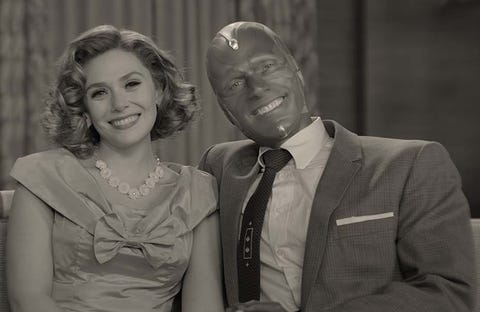
Theory #1: WandaVision is a spin on the comics arc House of M. (Confirmed.)
If you’ve spent any time digging around Marvel fan forums, you’ve probably already stumbled on this theory, and after episode 5 aired on February 5, it's virtually confirmed.
Here's the background: In 2005, Marvel Comics released a storyline called House of M, written by comics legend Brian Michael Bendis, in which an insane Scarlet Witch (aka Wanda Maximoff) has a mental breakdown and attempts to recreate the universe. You see, she’s lost her two children, Billy and Tommy (sound familiar?), as well as her grip on reality. The other Avengers and X-Men (in the comics, Wanda is a mutant) realize they must consider killing Wanda, because her reality-shaping powers pose an enormous threat to humanity if she cannot recover her sanity. (Again, we're seeing hints of this in WandaVision.)
Hearing the news of her pending execution, Wanda manifests a new world, an almost-perfect utopia where her children are alive, her superhero teammates are happy, and mutants rule the world. But it’s a dangerous lie, and when Wanda realizes what she’s done, she decides the solution is to rid the world of mutants like her. (You might have seen a comic panel circulating of Wanda whispering, “No more mutants.” It's very meme-able.) At that point, the majority of the mutant population lose their powers.
WandaVision can't and won't mirror House of M exactly because, at this point in the MCU, the X-Men and Avengers’ worlds have not yet collided. But it certainly seems that Wanda has created her own version of Westview out of grief. If you remember the events of Avengers: Infinity War and Endgame, you’ll recall that Wanda is forced to kill Vision while extracting an Infinity Stone from his forehead. He does not return to life in Endgame, and she tells Thanos, “You took everything from me.”
Given the revelations we witnessed during episodes 4 and 5, this all makes sense. When Monica Rambeau (Teyonah Parris) is sent spiraling back into the "real" world, she whispers, "It's all Wanda." We know Wanda's behind the "hex" surrounding Westview. What we don't know is how much of it she's controlling.
Theory #2: Wanda is the show's villain.
By the end of episode 3, "Now In Color," we'd watched Wanda "rewind" or "snap" her sitcom reality multiple times. It happens first when she watches a mysterious beekeeper rise from a manhole in episode 2, and again when Vision gets the sense not all is normal in Westview. Then, at the end of episode 3, Geraldine/Monica is banished from town after gently reminding Wanda that her twin brother, Pietro, died at the hands of Ultron in Avengers: Age of Ultron. As episode 4 reveals, Wanda didn't take kindly to this reminder and physically threw Geraldine out of the suburbs. After, she reminds Vision she has "everything under control."
We now know that Wanda is perfectly aware of what's going on, and she's orchestrating most—if not all—of it. She knows there's another world beyond Westview where her brother lived and died, and where Vision similarly lived and died. And she would prefer to stay in her sitcom world. Anything—or anyone—who seeks to threaten her fake reality is…well, removable.
Interestingly, in an interview with ELLE.com about WandaVision, Olsen mentioned, "With our show, you don't know what the villain is, or if there is one at all.” It's clear the S.W.O.R.D (Sentient World Observation and Response Department) team that's set up camp outside of Westview think she's that villain. Vision is starting to get that sense, too. But the pieces don't add up.
Here's why: Wanda is tortured by her own grief, by the mistakes she's made since the Sokovia disaster in Age of Ultron. The likelihood that she's blatantly disregarding human life for her own gain seems like a trap she wouldn't allow herself to fall into again—not easily, anyway. (Remember that, in episode 5, Monica says, "I don't believe this was a premeditated act of aggression.") That said, Wanda's desperate, and we all know what they say about desperate people. She might have allowed something supposedly harmless to become brutal by striking a deal with the wrong person.
That's where we bring in Mephisto.
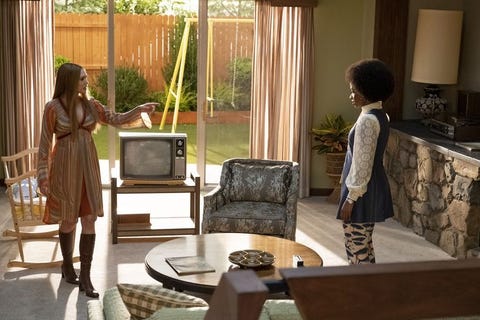
Theory #3: The series’ big bad is Mephisto.
Now let’s get deep into the weeds. WandaVision has given us little to no clues as to its major antagonist this season—except for, of course, Wanda herself.
But it could also be Mephisto. His character has been around since the 1960s, and he’s based on the Mephistopheles of German legend. Basically, he’s a demon-like creature, oft confused for Satan, who can shape-shift and alter time. Once upon a time, he served Thanos, much like Ronan and other big bads. Perhaps he’s manipulating Wanda, but it seems more likely the two of them made a pact—a deal with the devil, if you will. Perhaps, in return for her own sitcom-verse where Vision is alive, Wanda agreed to enter Mephisto’s domain and become trapped under his rule.
Here's why this theory holds so much weight: In episode 5, Wanda stresses multiple times that she doesn't know "how any of this started in the first place." When Vision confronts her, she seems horrified by his accusations, mystified that he thinks she's capable of controlling everyone in Westview at all times. Sure, she could be bluffing. But there's likely an element of truth to her defense. Perhaps something outside of her—maybe Mephisto?—is controlling her ability to control.
Theory #4: The Westview citizens know they're being controlled. Maybe they can do something about it.
Regardless of who is pulling the strings, the Westview denizens have some inkling of strange goings-on about town.
In episode 4, we learn that these kind folks are being "portrayed" by real humans. Darcy Lewis (an astrophysicist you'll recognize from the Thor films) and Jimmy Woo (a S.H.I.E.L.D.-turned-S.W.O.R.D. agent we met in Ant-Man and the Wasp) assemble a bulletin board covered with profiles of the characters and their real names: Norm is Abilash Tandon, Phil is Harold Proctor, Mr. Hart is Todd Davis, etc. These characters probably didn't volunteer to perform imaginary lives in Wanda's sitcom-verse, so they must be—to one degree or another—under her thumb.
But they're somehow self-aware. In episode 5, Agnes asks Wanda if she wants to "take it from the top" after Vision refuses to accept her questionable babysitting skills. Later, Wanda doesn't seem concerned about Agnes witnessing her and Vision using their powers—it's as if hiding doesn't matter anymore. And at Vision's office, Norm and Vision intercept an email from Darcy about the "Maximoff anomaly." Norm laughs it off: "It's a joke. Can't you tell? None of it is real." Then, when Vision clears his mind, he reveals, "She's in my head. None of it is my own. It hurts."
We're meant to assume that "she" is Wanda, of course. But does she know she's hurting them? And is it possible the Westview residents know more than they're revealing? Agnes, in particular, seems to have more information than she's sharing, even if it frightens her.
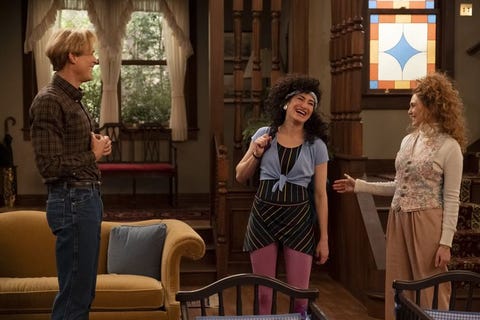
Theory #5: Billy and Tommy are the only children in Westview. That's purposeful.
At the end of episode 3, Wanda gives birth to twins Billy and Tommy. In the comics, these cuties are Billy and Tommy Maximoff, aka Wiccan and Speed, who have superpowers similar to Wanda and Pietro’s—hex abilities and super-speed.
Billy and Tommy are stupendous characters in their own right, and they eventually become leaders of the Young Avengers, another popular franchise that Marvel might have plans to cinema-tize. But they also have complicated origins: They’re actually created from fragments of a demon’s soul, and that realization is part of what originally drives Wanda insane during House of M.
What's most interesting about Wanda's relationship with the twins in WandaVision is that she can't seem to control them. She can't make them stop crying as infants. She can't stop their rapid age progression. And they seem to know more than she wants them to—like, for instance, that she "can fix anything," as Tommy stresses after their puppy, Sparky, dies.
Wanda responds, "I am trying to tell you that there are rules in life. We can't rush aging just because it's convenient. And we can't reverse death, no matter how sad it makes us. Some things are forever."
But we know from episode 5 this isn't true. Wanda resurrected Vision. S.W.O.R.D. has proof. She's rushing through the decades. And the twins can rush their own aging, which seems to imply they've inherited their mother's powers.
What this doesn't explain is why there are no other children in Westview, something Vision points out during a heated argument with his wife. Did they disappear? What if Wanda can't control children, as evidenced by her inability to control Billy and Tommy? What if, somehow, the Westview kids have already escaped Wanda's reality? There are too many missing pieces to understand the implications of that possibility yet. But it sure seems likely.
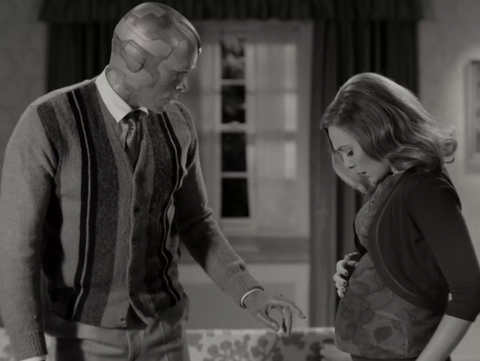
Theory #6: Monica Rambeau already has her superpowers. That's why she's uncomfortable with mentions of Captain Marvel.
By now, you know, of course, that Geraldine is not, in fact, "Geraldine." She's Monica Rambeau, and she disappeared during Thanos's snap in Endgame.
If you haven't already googled Monica's name in a mad fervor, here's what you need to know: She first appeared as a little girl in Captain Marvel. She was the super-cute daughter of Carol Danvers's best friend Maria, remember? Lieutenant Trouble? Well, a few years have passed since then, and it would seem Maria went on to found S.W.O.R.D. Maria raised her daughter in the hallways and control rooms of the organization, and Monica went on to become a respected agent in her own right. But, as we learn in episode 4, Maria contracted cancer, and she died during the time Monica disappeared in the "snap."
In the first moments of episode 4, Monica re-materializes after the Avengers reverse the snap, and she rejoins S.W.O.R.D. But she's temporarily "grounded," meaning she's assigned to lowly earthly tasks. That leads her to the doorstep of Westview, and eventually to Wanda giving her the boot.
Then, in episode 5, she awakens on the S.W.O.R.D. base to discover her lab results are mysteriously blank. The medic requests another blood draw, and Monica refuses. No explanation is given.
If we had to guess, Monica is hiding her own superpowers. WandaVision has yet to reveal if this adult Monica has any abilities, but in the comics, she has skills similar to Danvers—photon blasts, flight, the works. Over the years, Monica has claimed multiple aliases, including Photon, Spectrum, Pulsar, and even—yes—Captain Marvel. An Easter egg in episode 4 reveals that Maria, in fact, used "Photon" as a nickname at S.W.O.R.D. And in episode 5, Monica requests Darcy's team build a "10,000-pound fallout shelter comprised of lead for photons." It's doubtful that's a throwaway reference. I'm willing to bet Monica is gearing up to unleash her powers.
So, why does she look so remiss when Jimmy mentions Captain Marvel during one of their briefings? We can't know for sure. But we can assume it has something to do with '90s-era Danvers leaving Earth to spend 23 years exploring Outer Space. Maybe Maria or Monica had plans to become Earth's version of Captain Marvel after the real one seemingly jumped ship. It would make sense.

Theory #7: Pietro's return opens the doors to the X-Men universe.
If we know anything about the MCU, it’s that the creators aren’t afraid of ambitious storylines. Plus, more franchises = more $. And the X-Men franchise is a money-maker.
Disney owns the rights to X-Men, which is why you’ll see those films on your Disney+ queue. So it’s probably not absurd to assume the Avengers MCU and the X-Men universe will eventually collide on the silver screen, as they do in the comics. WandaVision could be what makes that happen.
By far the biggest reveal of episode 5 is Pietro Maximoff's return to the screen. Wanda's brother shows up at her doorstep, completely unexpected—and, apparently, not by her design—when the doorbell rings, she tells Vision, "I didn't do that." The door swings open, and there's Pietro…except not the one from Age of Ultron. This is Evan Peters' version of Pietro, who first appeared in X-Men: Days of Future Past.
This is the first time the worlds of the X-Men films and the MCU films have collided. Does this mean WandaVision's Pietro is from a different reality? Is he aware of where he is and how he got there? Might the mutants finally become a part of the MCU? We've got more questions than answers right now. But I'd be shocked if this isn't a precursor for an enormous crossover.
Theory #8: Agnes is really Agatha Harkness.
Here’s one that requires you to know a bit more comic lore. You first met Agnes (Kathryn Hahn), Wanda and Vision’s deliciously wry neighbor, in the WandaVision pilot. Sure, it's possible she's merely a quippy side-character, but I find that doubtful.
Several fans think she must be Agatha Harkness. In the comics universe, Harkness is an old (like, was-alive-before-the-sinking-of-Atlantis old) witch who escaped the Salem Witch Trials and went on to master mystical arts, later teaching them to a young Wanda Maximoff. In other points throughout the comics, she serves as Wanda’s antagonist, and she’s also the one who, after Wanda gives birth to twins Billy and Tommy, reveals to Wanda that the children are not, in fact, hers, but were born of more demonic origins. We don’t need to unpack all of that, but the point stands that Agatha has an important role in Wanda’s life—so it makes sense she’d appear in Wanda’s TV show.
Another interesting detail? In the comics, Agatha has a son named Nicholas Scratch. And the name of Agnes's bunny in WandaVision? Señor Scratchy.

Theory #9: The "missing person" is Mephisto.
In all the excitement of episodes 4 and 5, it's easy to forget that Monica and Jimmy first showed up in Westview because of a missing person case. But don't let that detail escape you. It could be a huge clue.
The missing person they're after—a male—is in the Witness Protection Program, and none of his known associates or relatives have even heard of him.
Bettany mentioned in an interview with the "Lights Camera Barstool" podcast that he works with a special mystery actor in WandaVision: “So many things get leaked, but there’s this thing that has been completely under wrap that happens. I work with this actor that I’ve always wanted to work with and we have fireworks together—the scenes are great and I think people are going to be really excited. I’ve always wanted to work with this guy and the scenes are pretty intense.”
Obviously this is an important character, and there's a reason he hasn't been revealed yet. Many fans think this mystery man is "Ralph," the husband Agnes mentions frequently who has yet to appear onscreen. Others think Ralph might just be Mephisto.
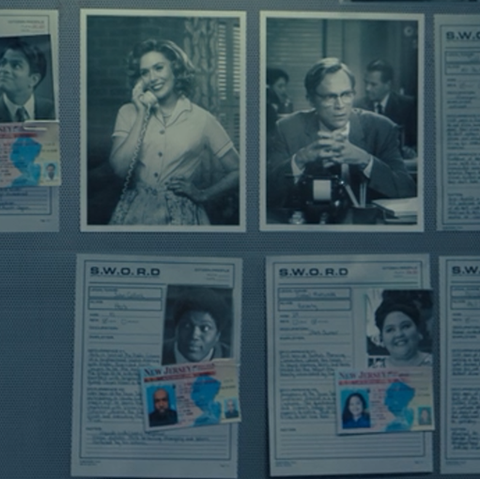
Theory #10: S.W.O.R.D. started all of this.
We know Mephisto is a solid guess for the show's villain. But Marvel also loves to reveal how corrupt people in power are the bad guys more often than demigods and mad titans. So what if, like in Captain America: The Winter Soldier, the real villain is someone we've already met?
We see in episode 5 that Wanda retrieved Vision's corpse from a S.W.O.R.D lab. If you look closely, you can see he was in pieces, completely dismantled and likely being experimented with. It's possible S.W.O.R.D itself was violating Vision's will and attempting to recreate him, so Wanda stole his body and resurrected him in order to rescue him.
If that's true, that means S.W.O.R.D. might have had a hand in Wanda's creation of Westview. And Director Hayward might know more about it than we've been led to believe.
Theory #11: WandaVision will tie directly into Doctor Strange in The Multiverse of Madness. (Confirmed.)
This theory is less about if than how. Marvel Studios president Kevin Feige confirmedWandaVision will tie into the film, and Olsen will star alongside Benedict Cumberbatch in March 2022's The Multiverse of Madness. So, what does that mean? Well, the theory of Wanda creating her own alternate reality within the multiverse could be true. And if she shows up in the next Doctor Strange, someone must pull her out of the sitcom-verse—and it could be the Master of the Mystical Arts himself.
Theory #12: The folks in the WandaVision commercials are Wanda’s parents.
Let’s tackle those fascinating commercials, shall we? Each promises a different Marvel Easter egg, and already, fans are dissecting screenshots for clues.
All the “commercials" different couples advertise different products. The first is a Stark Industries toaster, the second is a Strücker watch, the third is "Hydra Soak," a specialty bath product, and the fourth is a paper towel brand called "Lagos." If you’re an avid MCU fan, you’ll of course know Stark Industries is Tony Stark’s company, and Strücker is the last name of Baron von Strücker, the Hydra leader who recruited Wanda and her brother Pietro before Age of Ultron and gave them their powers.
Why is this significant? As one fan pointed out, the ads seem to be revisiting Wanda’s trauma: A Stark Industries bomb killed her parents, and Strücker corrupted Wanda and her brother, recruiting them for Hydra. Lagos is a reference to the town in which she accidentally destroyed a building, killing a number of residents inside.
But who are the man and woman in the Stark Industries commercial? One Twitter user suggested they could be Wanda and Pietro’s deceased parents, alive again in her pseudo-reality. Does this mean she can bring others back to life, such as Vision himself, or perhaps even her brother Pietro? Or is she simply imagining all these ghosts of the dead?

This story will be updated each week after new episodes of WandaVision drop.

